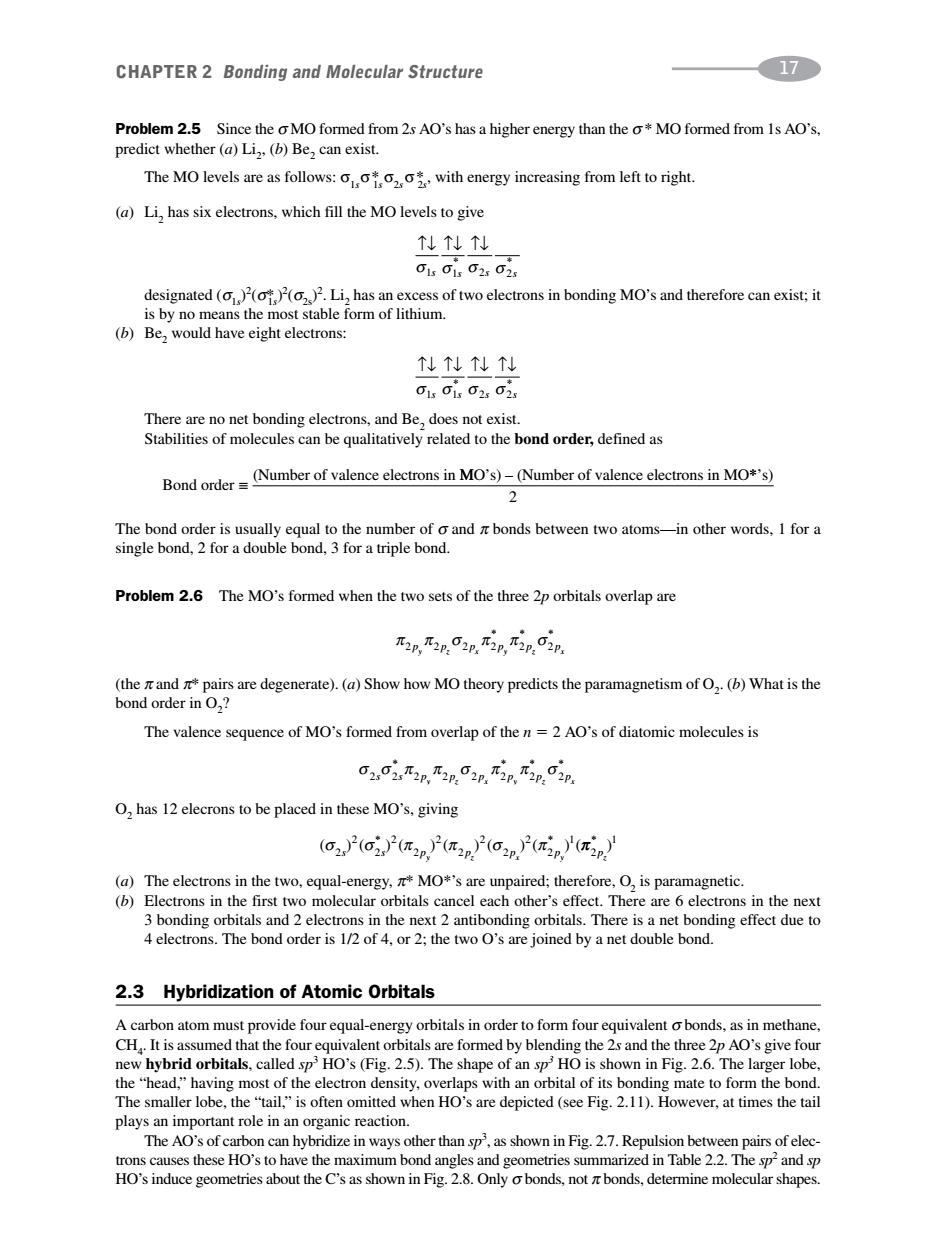正在加载图片...

CHAPTER 2 Bonding and Molecular Structure 17 e the o MO fom ed from2s AO's has a higher energy than from IsAO's. predict whet Liz.(b)Bez can exist. The MO levels are as follows:with energy increasing from left to right. (a)Li,has six electrons.which fill the MO levels to give 仙!! 0u0i,02x02 designated ((().Li,has an excess of two electrons in bonding MO's and therefore can exist:it is by no means the most stable form of lithium. (b)Be,would have eight electrons: 仙!仙付 01002,02 Bond orderNumber of valence eltro inMO)(Number of valence electrons inMO) The bond order is usually ual to the number of o and bonds between two atoms-in other words.I for a single bond,2 for a double bond,3 for a triple bond. Problem 2.6 The MO's formed when the two sets of the three 2p orbitals overlap are 2G2p2p.G2p )hw ry pis te()Was The valence sequence of MO's formed from overlap of then-2 AO's of diatomic molecules is 02.0i不n不2n02p不2nTin02n O has 12 elecrons to be placed in these MO's.giving ((pp)) 4 electrons.The bond order is 1/2 of 4.or 2:the two O's are joined by a net double bond. 2.3 Hybridization of Atomic Orbitals A carbon atom must provide four equal-energy orbitals in order to form four equivalent o bonds.as in methane CH It is assumed that the fourequivalent orbitals are formed by blending the 2s and the three 2p AO's give four new hybrid orbitals,called spHO's (Fig.2.5).The shape of an spHO is shown in Fig.2.6.The larger lobe ctron n orbital of g mate to form th plays an im ee Fig the a rtant role in an The AO's of carbon can hybridize in ways other than spas shown in Fig.2.7.Repulsion betwee pairs of elecProblem 2.5 Since the σ MO formed from 2s AO’s has a higher energy than the σ * MO formed from 1s AO’s, predict whether (a) Li2, (b) Be2 can exist. The MO levels are as follows: σ1s σ*1sσ2sσ*2s , with energy increasing from left to right. (a) Li2 has six electrons, which fill the MO levels to give CHAPTER 2 Bonding and Molecular Structure 17 ↑↓ ↑↓ ↑↓ σ1s σ1s σ 2s σ 2s * * designated (σ1s )2(σ*1s )2(σ2s)2 . Li2 has an excess of two electrons in bonding MO’s and therefore can exist; it is by no means the most stable form of lithium. (b) Be2 would have eight electrons: ↑↓ ↑↓ ↑↓ ↑↓ σ1s σ1s σ 2s σ 2s * * There are no net bonding electrons, and Be2 does not exist. Stabilities of molecules can be qualitatively related to the bond order, defined as Bond order (Number of valence electrons in ≡ MO’s) – (Number of valence electrons in MO*’s) 2 The bond order is usually equal to the number of σ and π bonds between two atoms—in other words, 1 for a single bond, 2 for a double bond, 3 for a triple bond. Problem 2.6 The MO’s formed when the two sets of the three 2p orbitals overlap are ππσππσ 222222 pppppp yz xyz x *** (the π and π* pairs are degenerate). (a) Show how MO theory predicts the paramagnetism of O2. (b) What is the bond order in O2? The valence sequence of MO’s formed from overlap of the n 2 AO’s of diatomic molecules is σσπ π σ π π σ 222 2 2 2 2 2 ssp p p p p p yz xyz x * * * * O2 has 12 elecrons to be placed in these MO’s, giving ( )( )( )( )( )( )( 22 2 2 2 1 σσπ π σ π 222 2 2 2 ssp p p p yzxy * * π 2 pz * ) 1 (a) The electrons in the two, equal-energy, π* MO*’s are unpaired; therefore, O2 is paramagnetic. (b) Electrons in the first two molecular orbitals cancel each other’s effect. There are 6 electrons in the next 3 bonding orbitals and 2 electrons in the next 2 antibonding orbitals. There is a net bonding effect due to 4 electrons. The bond order is 1/2 of 4, or 2; the two O’s are joined by a net double bond. 2.3 Hybridization of Atomic Orbitals A carbon atom must provide four equal-energy orbitals in order to form four equivalent σ bonds, as in methane, CH4 . It is assumed that the four equivalent orbitals are formed by blending the 2s and the three 2p AO’s give four new hybrid orbitals, called sp3 HO’s (Fig. 2.5). The shape of an sp3 HO is shown in Fig. 2.6. The larger lobe, the “head,” having most of the electron density, overlaps with an orbital of its bonding mate to form the bond. The smaller lobe, the “tail,” is often omitted when HO’s are depicted (see Fig. 2.11). However, at times the tail plays an important role in an organic reaction. The AO’s of carbon can hybridize in ways other than sp3 , as shown in Fig. 2.7. Repulsion between pairs of electrons causes these HO’s to have the maximum bond angles and geometries summarized in Table 2.2. The sp2 and sp HO’s induce geometries about the C’s as shown in Fig. 2.8. Only σ bonds, not π bonds, determine molecular shapes.�